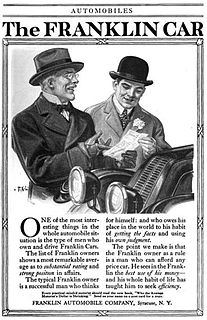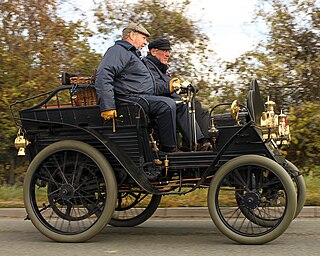Related Research Articles

The REO Motor Car Company was a company based in Lansing, Michigan, which produced automobiles and trucks from 1905 to 1975. At one point, the company also manufactured buses on its truck platforms.
The Pierce-Arrow Motor Car Company was an American motor vehicle manufacturer based in Buffalo, New York, which was active from 1901 to 1938. Although best known for its expensive luxury cars, Pierce-Arrow also manufactured commercial trucks, fire trucks, boats, camp trailers, motorcycles, and bicycles.

The Franklin Automobile Company was a marketer of automobiles in the United States between 1902 and 1934 in Syracuse, New York. Herbert H. Franklin, the founder, began his career in the metal die casting business before establishing his automobile enterprise. Controlled by Herbert H. Franklin it had very few other significant shareholders. Franklin bought its vehicles from the H. H. Franklin Manufacturing Company which was only moderately profitable and frequently missed dividends on common stock.

The Triumph Motor Company was a British car and motor manufacturing company in the 19th and 20th centuries. The marque had its origins in 1885 when Siegfried Bettmann of Nuremberg formed S. Bettmann & Co. and started importing bicycles from Europe and selling them under his own trade name in London. The trade name became "Triumph" the following year, and in 1887 Bettmann was joined by a partner, Moritz Schulte, also from Germany. In 1889, the businessmen started producing their own bicycles in Coventry, England.

The Standard Motor Company Limited was a motor vehicle manufacturer, founded in Coventry, England, in 1903 by Reginald Walter Maudslay. For many years, it manufactured Ferguson TE20 tractors powered by its Vanguard engine. All Standard's tractor assets were sold to Massey Ferguson in 1959. Standard purchased Triumph in 1945 and in 1959 officially changed its name to Standard-Triumph International and began to put the Triumph brand name on all its products. A new subsidiary took the name The Standard Motor Company Limited and took over the manufacture of the group's products.

Stoddard-Dayton was a high quality car manufactured by Dayton Motor Car Company in Dayton, Ohio, US, between 1905 and 1913. John W. Stoddard and his son Charles G. Stoddard were the principals in the company.

De Dion-Bouton was a French automobile manufacturer and railcar manufacturer operating from 1883 to 1953. The company was founded by the Marquis Jules-Albert de Dion, Georges Bouton, and Bouton's brother-in-law Charles Trépardoux.

The Mors automobile factory was an early French car manufacturer. It was one of the first to take part in automobile racing, beginning in 1897, due to the belief of the company founder, Émile Mors, in racing's technical and promotional benefits. By the turn of the century, automobile racing had become largely a contest between Mors and Panhard et Levassor.

The first Cadillac automobiles were the 1903 Model built in the last quarter of 1902. These were 2-seater "horseless carriages" powered by a reliable and sturdy 10 hp (7 kW) single-cylinder engine developed by Henry Martyn Leland and built by Leland and Faulconer Manufacturing Company of Detroit, of which Henry Leland was founder, vice-president and general manager.
F. B. Stearns and Company, later known as F.B. Stearns Company was an American manufacturer of luxury cars in Cleveland, Ohio marketed under the brand names Stearns from 1900 to 1911 then Stearns-Knight from 1911 until 1929.
Morris Cowley was a name given to various cars produced by Morris from 1915 to 1958.

Graham-Paige was an American automobile manufacturer founded by brothers Joseph B. Graham (1882-1970), Robert C. Graham (1885-1967), and Ray A. Graham (1887-1932) in 1927. Automobile production ceased in 1940, and its automotive assets were acquired by Kaiser-Frazer in 1947. As a corporate entity, the Graham-Paige name continued until 1962.

Moon Motor Car Company was an American automobile company that was located in St. Louis, Missouri. The company had a venerable reputation among the buying public, as it was known for fully assembled, easily affordable mid-level cars using high-quality parts. Often this meant the manufacturing process required more human intervention, leading to operating losses. The company was founded by carriage maker Joseph W. Moon. Moon produced both cars and trucks.
The Windsor was an automobile produced in St. Louis, Missouri, United States, from 1929 to 1930 by the Windsor Corporation.

The Union automobile was a vehicle manufactured by the Union Automobile Company from 1902 until 1905. It was designed by John William Lambert, who had developed the three-wheel Buckeye gasoline buggy in 1891. Over the next decade, Lambert substantially refined the vehicle, with modifications including an additional wheel, a more powerful engine, and a new transmission system. The Union Automobile Company was formed as a subsidiary of Lambert's Buckeye Manufacturing Company solely to manufacture the Union, which took its name from Union City, Indiana, the city where it was built and which endorsed its production. In total, the company built over three hundred Union automobiles, before development shifted to the Lambert automobile, the Union's successor.
The George W. Davis Motor Car Company made Davis brand automobiles in Richmond, Indiana from 1908 to 1929.
The Derby Motor Cars Ltd. was a Canadian automobile built in Saskatchewan between 1924 and 1927. Company principal Louis Arsenault believed that with a booming wheat trade in the Prairies, customers and investors would support a car company. Arsenault opened an office for Derby Motors in Winnipeg, Manitoba, in early 1924, following the dissolution of Winnipeg Motor Cars Ltd. in fall 1923.

Iris was a British car brand that was manufactured from 1906-1925 by Legros & Knowles Ltd in Willesden, London and Aylesbury, Buckinghamshire.

The Chrysler Six was a series of cars that were all installed with the Chrysler Straight Six when the company assumed operations of the Maxwell Automobile Company in 1924, and Chalmers Automobile Company in 1926. The Chrysler Six initially consisted of several Models, then Series designations that originally declared the approximate top speed each vehicle was able to consistently maintain, then each series number was incrementally updated every new model year, and each series was offered in several body style choices. The engines were technically advanced for their time and were entered in the 24 Hours of Le Mans for 1925, 1928 and 1929.
The Welch Motor Company was an American automobile company headquartered in Chelsea, Michigan. It started in 1901 and continued production of luxury vehicles until 1911 when it merged with General Motors.
References
- 1 2 3 4 5 6 7 8 9 Durnford, Hugh (1973). Cars of Canada. Canada: McClelland and Stewart. p. 384. ISBN 0771029578.
- ↑ Georgano, Nick (2000). The Beaulieu Encyclopedia of the Automobile. London: Stationery Office. p. 1792. ISBN 0117023191.